
I actually came to know Mary Fedden’s work in a round about sort of way. Truth is, her name was so frequently mentioned as an inspiration or influence by so many of my favorite British creators that I simply had to learn more.
Turns out she’s one of Britain’s finest and best-loved contemporary artists, one who painted daily right up until her passing in 2012 at age 96. She’s most well known for her distinctive still lifes, characterized by a bold use of color, odd and inventive perspectives, and flat picture planes.

She made the ordinary extraordinary with her signature näive yet sophisticated style, elevating the beauty of favorite subjects such as fruits, feathers and plants. Her extensive body of work spanned over seven decades.
Born in Bristol, England in 1915, Mary hated and dropped out of Badminton girls’ school to attend the Slade School of Fine Arts in London at age 16. While there, she studied under Russian scene painter Vladimir Polunin, who had worked with the Ballets Russes and with Pablo Picasso.



After completing her studies, she briefly designed sets for Sadler’s Wells before returning to Bristol to work as a teacher and portrait painter. Polunin’s influence was evident in her opulent palette, reminiscent of the sumptuous colors of the ballet’s sets and costumes.


With the outbreak of WWII in 1939, Fedden served in the Women’s Land Army and Women’s Voluntary Service, where she was commissioned to create murals for the war effort. She later worked as a driver for the NAAFI in Europe.
It wasn’t until after the war that Fedden began to develop her singular style, focussing on her love of still life while being fascinated by impressionist, post-impressionist, and contemporary abstract artists such as Matisse and Braque. It’s been said “she married a very English sensibility to a modern European one,” with Ben Nicholson and Christopher Wood having had the most notable impact.


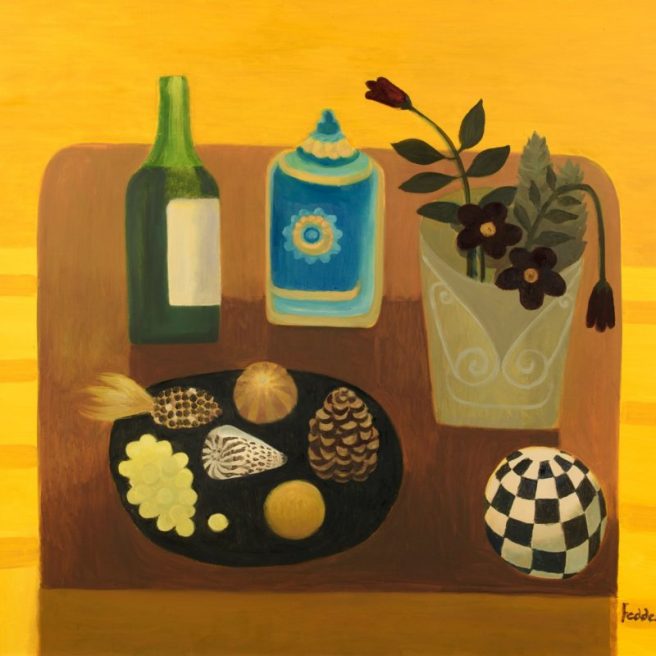
I really float from influence to influence. I found the early Ben Nicholson’ s fascinating as were the paintings of his wife Winifred. I also admire the Scottish artist Anne Redpath and the French painter Henri Hayden.
At about this same time, she reunited with acclaimed artist, poet, and printmaker Julian Trevelyan, whom she had met years earlier at the Slade. They married in 1951 and lived at Trevelyan’s Durham Wharf Studio on the Thames.
As her best critic and sometime collaborator, he would remain a key influence on her work. Their world travels inspired Trevelyan to pursue his passion for realistic painting, something kept secret during his pre-war, surrealist period.
While abroad, Fedden amassed a huge body of drawings and sketches, mainly landscapes done in pen or pencil (devoid of color), which she would later use as inspiration back in her studio.

Fedden was endlessly fascinated by the shape and form of everyday objects, carefully orchestrating her compositions to draw out the unique beauty of these objects — whether the textures of feathers or stones, or the patterns on vases or butterfly wings.



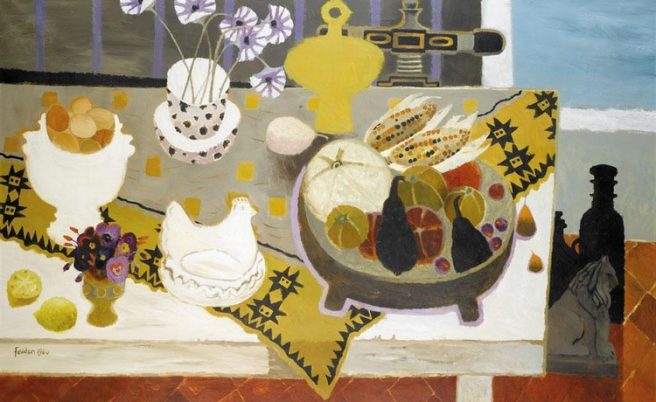
By playing with scale, perspective, and lighting, she was able to create paintings more complex than simple still lifes, characterized by objects pushed to the front of the plane with floating, unmanifested support, and a distinct landscape behind. She claims her chosen objects had no symbolic meaning; they were simply things she liked painting.
Each of my paintings is a mixture of the things I am looking at, and my thoughts and imagination . . . I use objects a lot, but I never set up a conventional still-life composition and work from that.
She worked mainly in gouache and oils, and at times used some of Trevelyan’s rejected etchings as source material for her collages.

Equally as interesting is Fedden’s depictions of cats. They appear statuesque and commanding, frozen in time, proud to be gazed upon in a work of art. Mary and Julian always had cats in their home, so she was well acquainted with their uncanny ways.
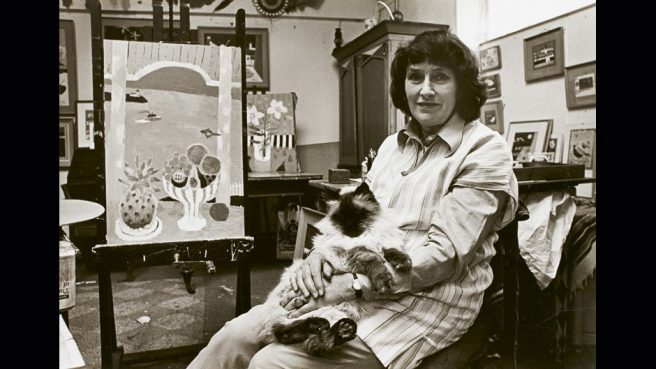

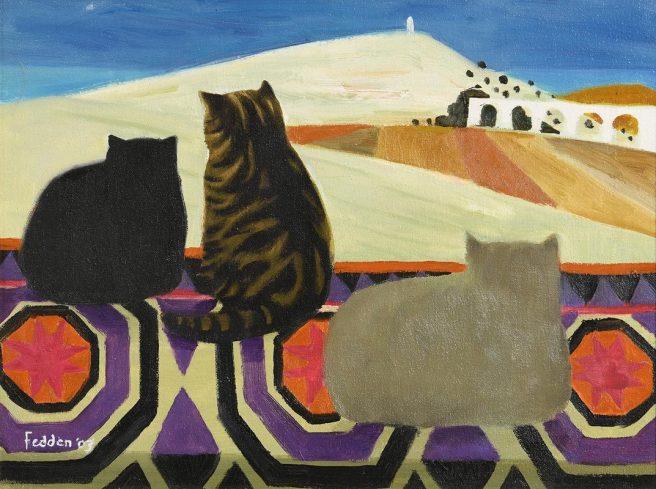

Mary was also able to indulge her deep rooted love of cats with her illustrations for the children’s book, Motley the Cat, written by Susannah Amoore (1997). The charming pictures showcase Fedden’s brilliant use of color and visual storytelling skills, and are understandably more playful than her still life cat pieces.

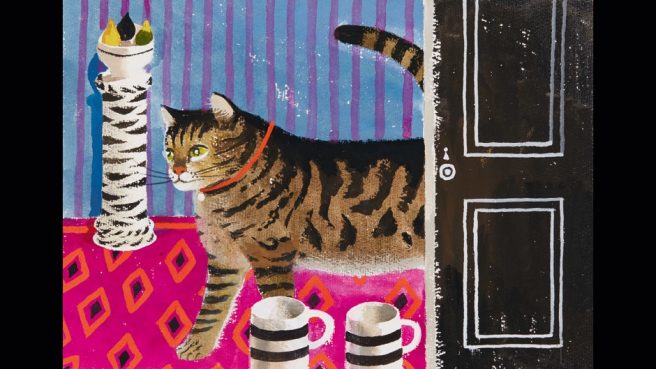




From 1958 to 1964, Fedden taught at the Royal College of Art, breaking ground as the first-ever female tutor in the Painting School at a time when talented females were discouraged from even applying to study there. Her pupils included David Hockney and Allen Jones. She subsequently taught at the Yehudi Menuhin School from 1964 to 1974, and was elected Royal Academician in 1992.

From 1984 to 1988 she served as President of the Royal West of England Academy (Bristol). She was also awarded an honorary doctorate from the University of Bath and an O.B.E. (1997).

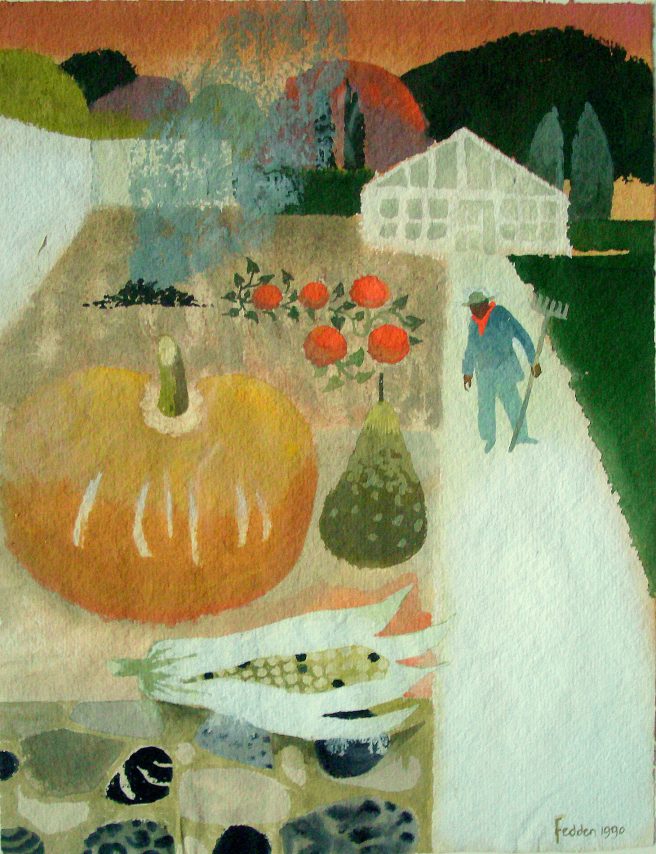
Fedden exhibited in one-person shows throughout the UK every year from 1947 until her passing in 2012. These included the Mansard Gallery (1947), the Redfern Gallery in London (from 1953), the New Grafton Gallery in London (from the 1960s), and the Beaux Art Galleries (1990s). A major exhibition of her work was held at the Royal West of England Academy in 1996.
Her work is held in numerous public and private collections, including the Tate Gallery, HM the Queen’s Collection, the Royal Academy in London, the UK Government Art Collection, Durham University, and the University of Bath.





In 2009 the Portland Gallery in London was appointed to represent the estate of Mary Fedden. You can find information about past Fedden exhibitions, as well as available works at the Portland Gallery website.
Mary Fedden art cards may be purchased via the Blank Card Company.

Fedden’s work remains as fresh, innovative, and aesthetically satisfying today as it did when first created, and she influenced a whole generation of contemporary painters with her unique still life-landscape hybrid compositions (Este MacLeod, Jane Walker, Emma Dunbar).


Whereas her status as an artist was once considered secondary to her husband’s (she was ‘merely’ his protegee, “a minor producer of charming still lifes”), since her death her paintings have attracted the interest of collectors and enthusiasts all over the globe.
The art world finally became more appreciative of her idiosyncratic style, and now there is an established Fedden market (her work has sold for as much as £100,000).

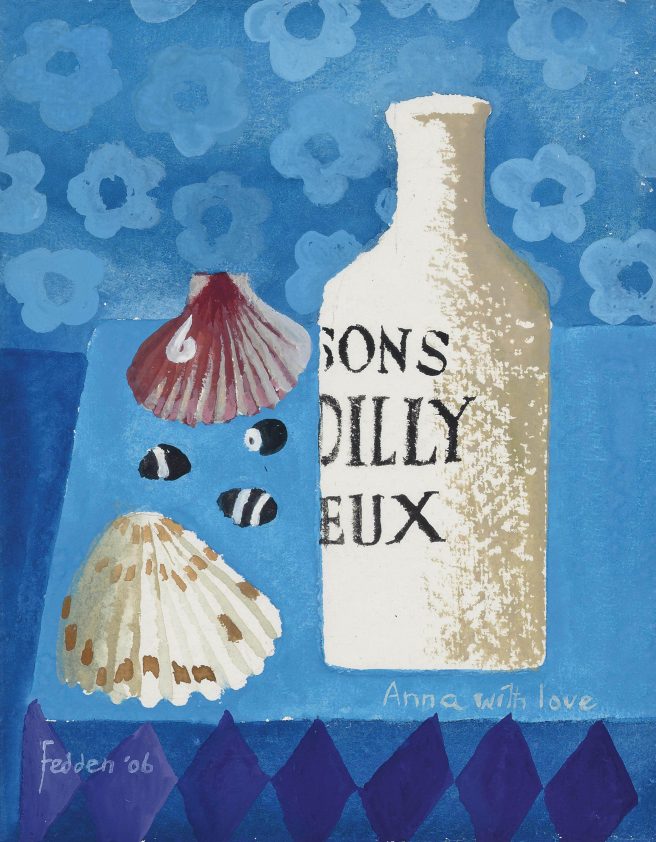
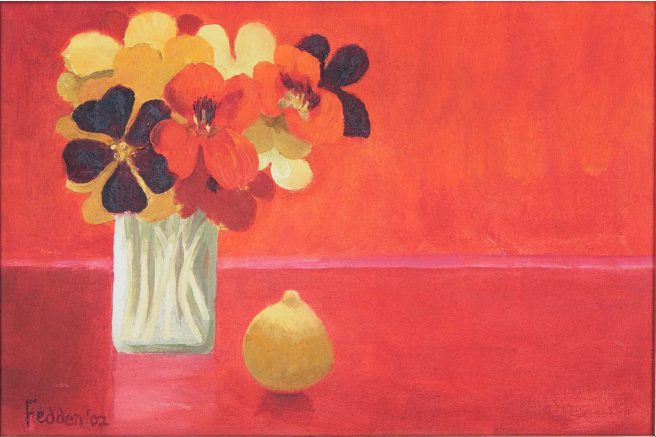

Trevelyan’s and Fedden’s legacy also lives on in their Durham Wharf Studio (Hammersmith). In 2016, paintings from their personal collection (including work by Picasso and Henry Moore) were auctioned off to fund development of the historic building into a not-for-profit arts centre for artists often priced out of studios in the capital.



A nice bit of serendipity: While reading about Mary Fedden, I noticed an Emma Bridgewater teapot in my hutch I hadn’t used in awhile. I’d owned it for over 20 years and decided to give it some love.

After washing and drying it, I turned it over, and low and behold — the pattern, called “Egg & Feather” was designed by — you guessed it — Mary Fedden!

I’m thinking when I first purchased the teapot I had probably glanced at the name but it didn’t ring a bell. This goes to show just how popular Mary Fedden is in the UK. I only wish I had been more familiar with her work sooner.


Of course now I love and appreciate my Egg & Feather teapot even more, and am doubly thrilled that back then I decided to also buy some matching cups! **claps hands together with glee**
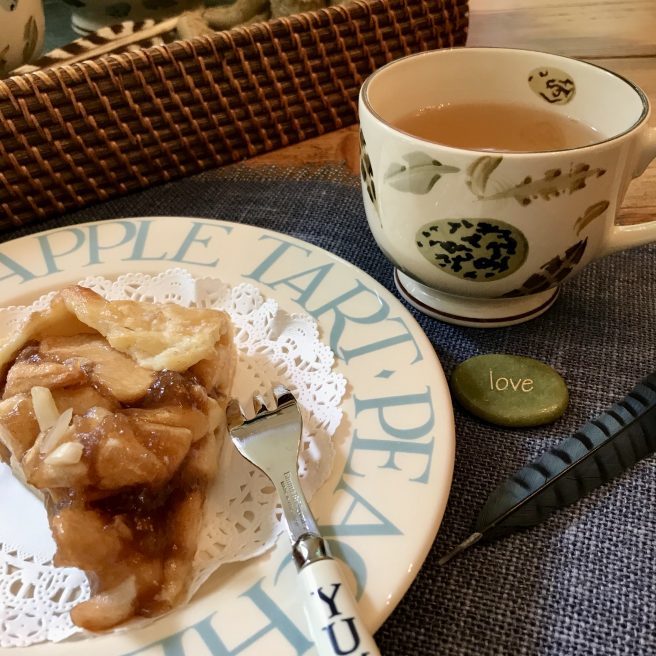
Here’s to the elevated beauty of ordinary objects, to the art of looking closer. Thank you, Mary Fedden!
Enjoy this short trailer from “The Art of Mary Fedden” documentary. She’s a leftie! 🙂
Here’s another video showcasing over 100 of her works. You’ll be able to see a wider range of pieces, including landscapes and figurative paintings. Relax and enjoy!
*
*Copyright © 2021 Jama Rattigan of Jama’s Alphabet Soup. All rights reserved.



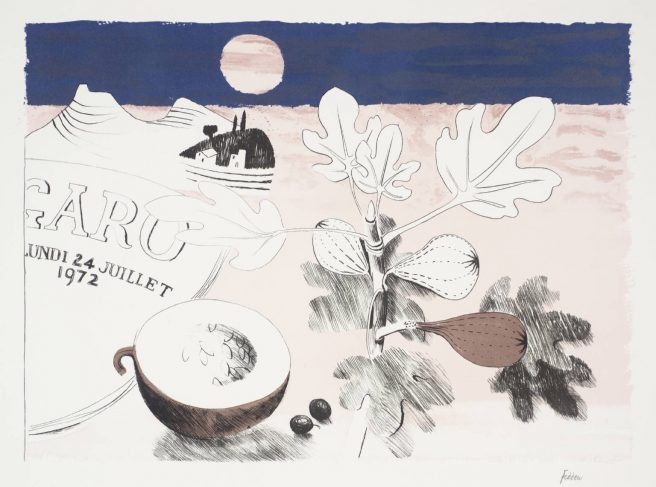


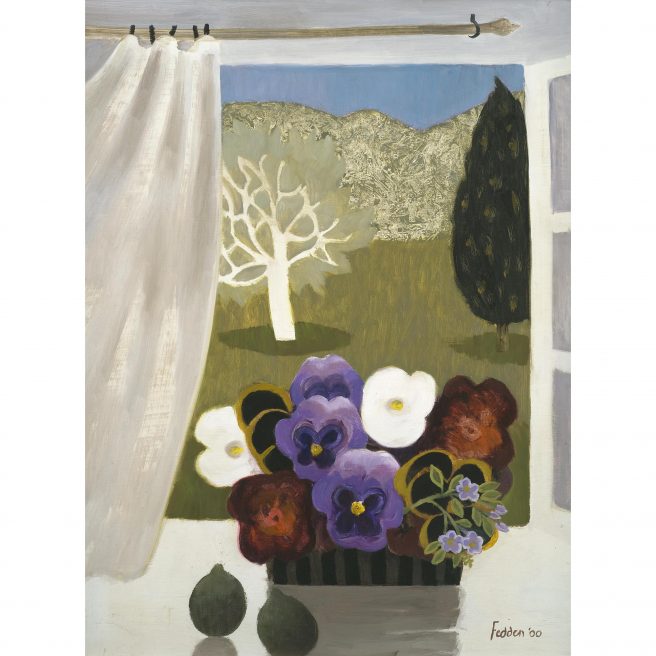

I love these paintings, especially the cats! Thank you for this gorgeous blog post. Enjoy your tea brewed in that cozy teapot! Mrs Potts would approve!
LikeLiked by 1 person
She did have a special way with cats, didn’t she? She captured their attitude perfectly. 🙂
LikeLike
Wow, thank you so much for turning me on to Mary Fedden. I love her compositions and her watercolors are just luscious. I am thrilled to discover her.
LikeLiked by 1 person
Glad you enjoyed seeing her work, Ashley. Her style is so distinctive, very inventive compositions. 🙂
LikeLike
Thanks for sharing this new to me artist Mary Fedden, and her inspiring, gorgeous art Jama! And how special to discover she created the design of your teapot set, ❤️ All!
LikeLiked by 1 person
That teapot has pride of place in our kitchen now. 🙂
LikeLike
Another amazing post, Jama. All new to me and I enjoyed how you gave us this wonder of an artist introduction. It was lovely to hear from her, too, and to read of your surprise teapot! It always catches my breath to read “‘merely’ his protege” from the past histories of such accomplished women. Thanks for all! Happy Tuesday!
LikeLiked by 2 people
There are so many female artists like Fedden, who didn’t receive the full credit they deserved while still alive. Lucky for us she kept painting anyway and left behind an impressive body of work.
LikeLiked by 1 person
Thanks for the Fedden fest. Her work is inspiring. I had known and admired her still life paintings, but I didn’t know her story.
LikeLiked by 2 people
Wish I had known about her sooner. I found her story interesting, esp. the early Ballet Russe influences.
LikeLike
So much to see and feel in her work, thank you, Jama.
LikeLiked by 1 person
Thanks for stopping by, Wendy. Glad you enjoyed seeing Mary’s work.
LikeLike
Thank you for introducing me to Mary’s work. It’s so expressive. And this bird and tea lover adores that teapot!!
LikeLiked by 1 person
Maybe I should use that teapot more often and it will inspire me to be more creative. 🙂
LikeLike
Thanks for another beautiful and interesting post.
LikeLiked by 1 person
Glad you enjoyed it, Rosi!
LikeLike